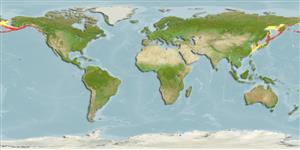Environment: milieu / climate zone / depth range / distribution range
Οικολογία
Θαλασσινό(ά) βενθικό(ς); εύρος βάθους 0 - 335 m (Ref. 50550), usually ? - 70 m (Ref. 51666). Temperate; 66°N -
Northwest Pacific: western Bering Sea, Sea of Okhotsk, coasts of Japan to central Honshu, Sea of Japan to Korean Peninsula.
Μέγεθος / Βάρος / Age
Maturity: Lm ? range ? - ? cm
Max length : 20.0 cm SL αρσενικό/απροσδιόριστο; (Ref. 559)
Found near shore among algae and rocks; usually shallower than 70 meters, but recorded to more than 300 meters (Ref. 51666).
Life cycle and mating behavior
Γεννητική Ωρίμανση | Αναπαραγωγή | Γεννοβολία | Αβγά | Γονιμότητα | Προνύμφες
Masuda, H., K. Amaoka, C. Araga, T. Uyeno and T. Yoshino, 1984. The fishes of the Japanese Archipelago. Vol. 1. Tokai University Press, Tokyo, Japan. 437 p. (text). (Ref. 559)
IUCN Red List Status (Ref. 130435: Version 2024-1)
Threat to humans
Harmless
Human uses
Εργαλεία
Special reports
Download XML
Διαδικτυακές πηγές
Estimates based on models
Preferred temperature (Ref.
123201): 1.4 - 14, mean 5.1 °C (based on 142 cells).
Phylogenetic diversity index (Ref.
82804): PD
50 = 0.6250 [Uniqueness, from 0.5 = low to 2.0 = high].
Bayesian length-weight: a=0.00389 (0.00180 - 0.00842), b=3.12 (2.94 - 3.30), in cm total length, based on all LWR estimates for this body shape (Ref.
93245).
Τροφικό Επίπεδο (Ref.
69278): 3.3 ±0.5 se; based on size and trophs of closest relatives
Fishing Vulnerability (Ref.
59153): Low vulnerability (14 of 100).
Nutrients (Ref.
124155): Calcium = 59.1 [31.7, 112.3] mg/100g; Iron = 0.363 [0.209, 0.668] mg/100g; Protein = 17.6 [16.6, 18.5] %; Omega3 = 0.462 [0.243, 0.826] g/100g; Selenium = 14.9 [7.1, 30.8] μg/100g; VitaminA = 23.6 [6.3, 84.4] μg/100g; Zinc = 0.787 [0.547, 1.143] mg/100g (wet weight);
